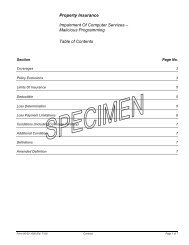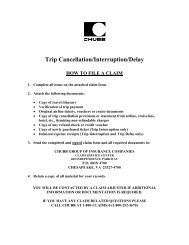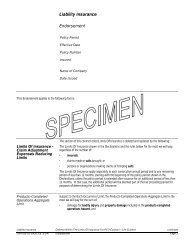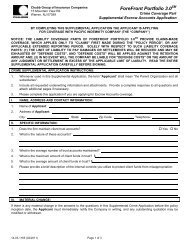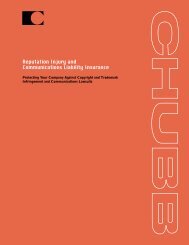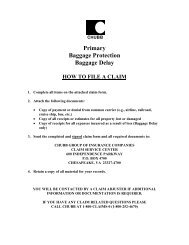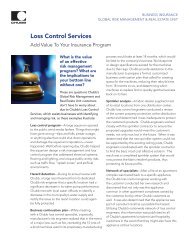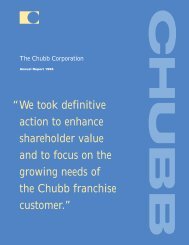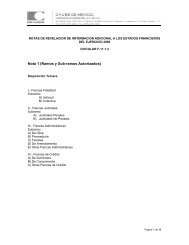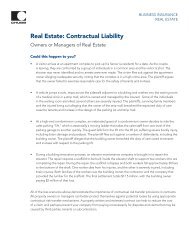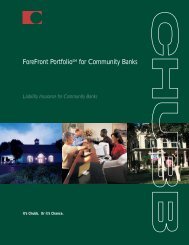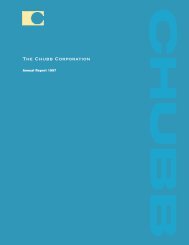Annual Report 2005 - Chubb Group of Insurance Companies
Annual Report 2005 - Chubb Group of Insurance Companies
Annual Report 2005 - Chubb Group of Insurance Companies
You also want an ePaper? Increase the reach of your titles
YUMPU automatically turns print PDFs into web optimized ePapers that Google loves.
The following table presents the number <strong>of</strong> policyholders for whom we have open asbestos case<br />
reserves and the related net loss reserves at December 31, <strong>2005</strong> as well as the net losses paid during<br />
<strong>2005</strong> by component.<br />
Number <strong>of</strong> Net Loss Net Losses<br />
Policyholders Reserves Paid<br />
(in millions)<br />
Traditional defendantsÏÏÏÏÏÏÏÏÏÏÏÏÏÏÏÏÏÏÏÏÏÏÏÏÏÏÏ 21 $334 $10<br />
Peripheral defendants ÏÏÏÏÏÏÏÏÏÏÏÏÏÏÏÏÏÏÏÏÏÏÏÏÏÏÏ 375 378 51<br />
Future claims from unknown policyholders ÏÏÏÏÏÏÏÏ 168 Ì<br />
$880 $61<br />
SigniÑcant uncertainty remains as to our ultimate liability related to asbestos related claims. This<br />
uncertainty is due to several factors including:<br />
‚the long latency period between asbestos exposure and disease manifestation and the resulting<br />
potential for involvement <strong>of</strong> multiple policy periods for individual claims;<br />
‚plaintiÅs' increased focus on peripheral defendants;<br />
‚the increase in the volume <strong>of</strong> claims by unimpaired plaintiÅs and the extent to which they can<br />
be precluded from making claims;<br />
‚the eÅorts by insureds to obtain coverage not subject to aggregate limits;<br />
‚the number <strong>of</strong> insureds seeking bankruptcy protection as a result <strong>of</strong> asbestos related liabilities<br />
and the impact <strong>of</strong> prepackaged bankruptcies;<br />
‚the ability <strong>of</strong> claimants to bring a claim in a state in which they have no residency or exposure;<br />
‚inconsistent court decisions and diverging legal interpretations; and<br />
‚the possibility, however remote, <strong>of</strong> federal legislation that would address the asbestos problem.<br />
These signiÑcant uncertainties are not likely to be resolved deÑnitively in the near future. While<br />
there have been some positive legislative and judicial developments in the asbestos arena over the past<br />
two years, it is too early to call it a trend.<br />
Toxic Waste Reserves. Toxic waste claims relate primarily to pollution and related cleanup costs.<br />
Our insureds have two potential areas <strong>of</strong> exposure Ìhazardous waste dump sites and pollution at the<br />
insured site primarily from underground storage tanks and manufacturing processes.<br />
Under the federal ""Superfund'' law and similar state statutes, when potentially responsible parties<br />
(PRPs) fail to handle the clean-up at a hazardous waste site, regulators have the work done and then<br />
attempt to establish legal liability against the PRPs. Most sites have multiple PRPs.<br />
Most PRPs named to date are parties who have been generators, transporters, past or present<br />
landowners or past or present site operators. The PRPs disposed <strong>of</strong> toxic materials at a waste dump site<br />
or transported the materials to the site. These PRPs had proper government authorization in many<br />
instances. <strong>Insurance</strong> policies issued to PRPs were not intended to cover the clean-up costs <strong>of</strong> pollution<br />
and, in many cases, did not intend to cover the pollution itself. Pollution was not a recognized hazard<br />
at the time many <strong>of</strong> these policies were written. In more recent years, however, policies speciÑcally<br />
excluded such exposures.<br />
As the costs <strong>of</strong> environmental clean-up became substantial, PRPs and others increasingly Ñled<br />
claims with their insurance carriers. Litigation against insurers extends to issues <strong>of</strong> liability, coverage<br />
and other policy provisions.<br />
There is substantial uncertainty involved in estimating our liabilities related to these claims. First,<br />
the liabilities <strong>of</strong> the claimants are extremely diÇcult to estimate. At any given waste site, the allocation<br />
<strong>of</strong> remediation costs among governmental authorities and the PRPs varies greatly depending on a<br />
44



